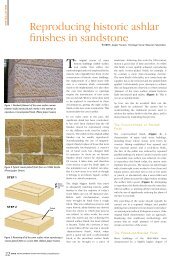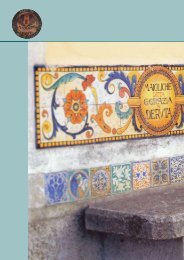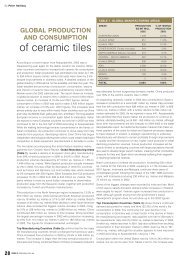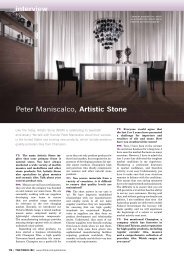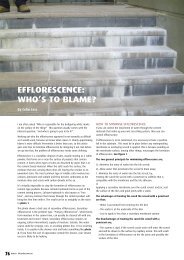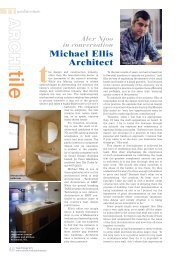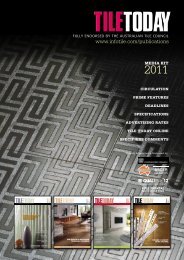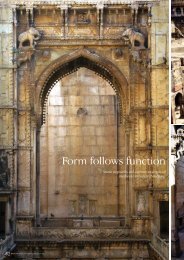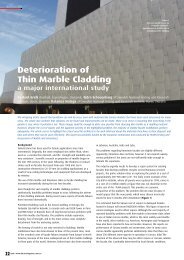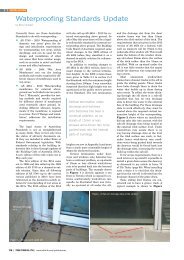A history of Italian tiles - Infotile
A history of Italian tiles - Infotile
A history of Italian tiles - Infotile
You also want an ePaper? Increase the reach of your titles
YUMPU automatically turns print PDFs into web optimized ePapers that Google loves.
comments on Giotto, above). Art<br />
for him is a matter not <strong>of</strong> outward<br />
splendour; its splendours are cerebral<br />
ones. With Leonardo art was constantly<br />
being replaced by the desire to know.<br />
The method was more important than<br />
the results.<br />
Knowledge was valued as something<br />
desirable in itself, and while certain<br />
areas were <strong>of</strong>f-limits to the over<br />
zealous mind and eye, such as doctrine<br />
(consider the Churches treatment<br />
<strong>of</strong> Galileo), the burgeoning number<br />
<strong>of</strong> universities, the importance <strong>of</strong><br />
libraries, the impact <strong>of</strong> printing, were<br />
all signs <strong>of</strong> the desire for knowledge<br />
and the wish to know the truth <strong>of</strong><br />
things. Man himself became a less<br />
passive creature, less the subject <strong>of</strong><br />
revelation and more himself the one<br />
who revealed.<br />
With an understated flourish my duck<br />
liver and spinach torta was placed<br />
before me. Here was a revelation<br />
indeed.<br />
Rinascimento art encouraged the<br />
spectator to reflect on his own<br />
reactions, both mental and physical,<br />
to what he was looking at. Beyond<br />
the researches <strong>of</strong> Paolo Uccello<br />
in the field <strong>of</strong> perspective or the<br />
technical innovations <strong>of</strong> Brunelleschi’s<br />
architecture, a special knowledge was<br />
enshrined: knowledge not only <strong>of</strong> what<br />
the eye could see and the hand could<br />
accomplish, but self knowledge. No<br />
more simply the minutely observed<br />
surface detail <strong>of</strong> Giotto’s naturalism<br />
but psychological insight. When we<br />
view Early Rinascimento masterpieces<br />
we are meant to refer back to our<br />
own experience and thus confirm<br />
their utter truthfulness. Experience<br />
has passed from being a subjective<br />
state <strong>of</strong> mind into being objectively<br />
rendered in stone and paint.<br />
This new relationship between what<br />
art expresses and what a human being<br />
perceives and feels is shown to crystal<br />
perfection in two masterpieces (clearly<br />
there are many others, but Bodkin<br />
singles these two out): Mantegna’s<br />
fresco <strong>of</strong> the Gonzaga court <strong>of</strong> Mantua,<br />
and the ‘Mona Lisa’. In Mantegna’s<br />
fresco the Gonzaga court are not being<br />
put on public display, nor are they<br />
stirring us to admire their heroism or<br />
their beauty or their virtue, only their<br />
vitality. No claim is made for these<br />
people except that they are human<br />
- thence comes their dignity. With the<br />
‘Mona Lisa’ her realism is not a matter<br />
<strong>of</strong> surfaces but <strong>of</strong> depth. This is not<br />
so much what a person actually looks<br />
like as an attempt to convey in paint<br />
the impression <strong>of</strong> a personality. She<br />
comes to us without title or wealth,<br />
an ordinary, rather plain woman,<br />
nevertheless meriting our attention<br />
and respect, as she did Leonardo’s, by<br />
virtue <strong>of</strong> her humanity.<br />
Art <strong>of</strong> all kinds was seeking - and<br />
finding - new methods <strong>of</strong> involving<br />
people in its aura, postulating a climate<br />
<strong>of</strong> pleasure rather than instruction.<br />
The decorative arts were no longer<br />
employed solely to serve the Church<br />
and Princes, but helped to make a<br />
prosperous citizen’s environment<br />
agreeable and ‘artistic’.<br />
Unlike some later art theorists,<br />
the architect Leon Battista Alberti<br />
emphasised that painting attempts<br />
to please the masses and he saw<br />
nothing wrong in that. Behind all his<br />
artistic instructions there is clearly<br />
present the standard <strong>of</strong> man, his<br />
needs and legitimate pleasures. For<br />
Alberti, as for the ancient Greeks<br />
“man is the measure <strong>of</strong> all things.”<br />
In his architectural treatise DE RE<br />
AEDIFICATORIA he takes a broad<br />
civic view <strong>of</strong> his subject... The city<br />
becomes virtually a mirror <strong>of</strong> the<br />
harmoniously arranged universe, with<br />
all its buildings disposed according to<br />
their function. The ultimate purpose<br />
<strong>of</strong> the city is to provide the best<br />
possible setting in which the citizens<br />
can live. The architect’s purpose is to<br />
“serve successfully and with dignity<br />
the needs <strong>of</strong> man.”<br />
figure E<br />
Alberti maintains that man remains<br />
the standard, not only in the sense <strong>of</strong><br />
creating and inhabiting what is built, but<br />
in giving his proportions as the standard<br />
by which a harmonious building is<br />
judged. Luca Pacioli, a pupil <strong>of</strong> Piero<br />
della Francesca and friend <strong>of</strong> Alberti and<br />
Leonardo, claimed that in the human<br />
body were to be found all ratios and<br />
proportions “by which God reveals the<br />
innermost secrets <strong>of</strong> nature.”<br />
The aim <strong>of</strong> such art is clear: to express<br />
the fundamental cosmic truths <strong>of</strong><br />
proportion, order and harmony which<br />
lie beneath external appearances.<br />
Restraint is essential. Exaggerated<br />
ornament is likely to militate against<br />
true beauty: “a certain regular harmony<br />
<strong>of</strong> all parts <strong>of</strong> a thing, <strong>of</strong> such a kind<br />
that nothing could be added or taken<br />
away or altered without making it less<br />
pleasing” (Alberti), words that applied<br />
equally to the superb torta I had just<br />
eaten as they did to Alberti’s vision <strong>of</strong><br />
architectural perfection.<br />
But ‘take away’ he did; at least my<br />
empty plate, returning soon after with<br />
the balsamic vinegar ice-cream and<br />
an expresso. As the last spoonful<br />
<strong>of</strong> ice-cream melted in my mouth I<br />
remembered that it was in Sicily that<br />
ice-cream had been invented - the<br />
Arab influence again. Bodkin was right,<br />
I thought, when he wrote towards the<br />
beginning <strong>of</strong> the third volume that<br />
“transmission across several cultures,<br />
whether happily or unhappily, was<br />
an integral part <strong>of</strong> the Rinascimento



